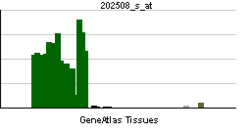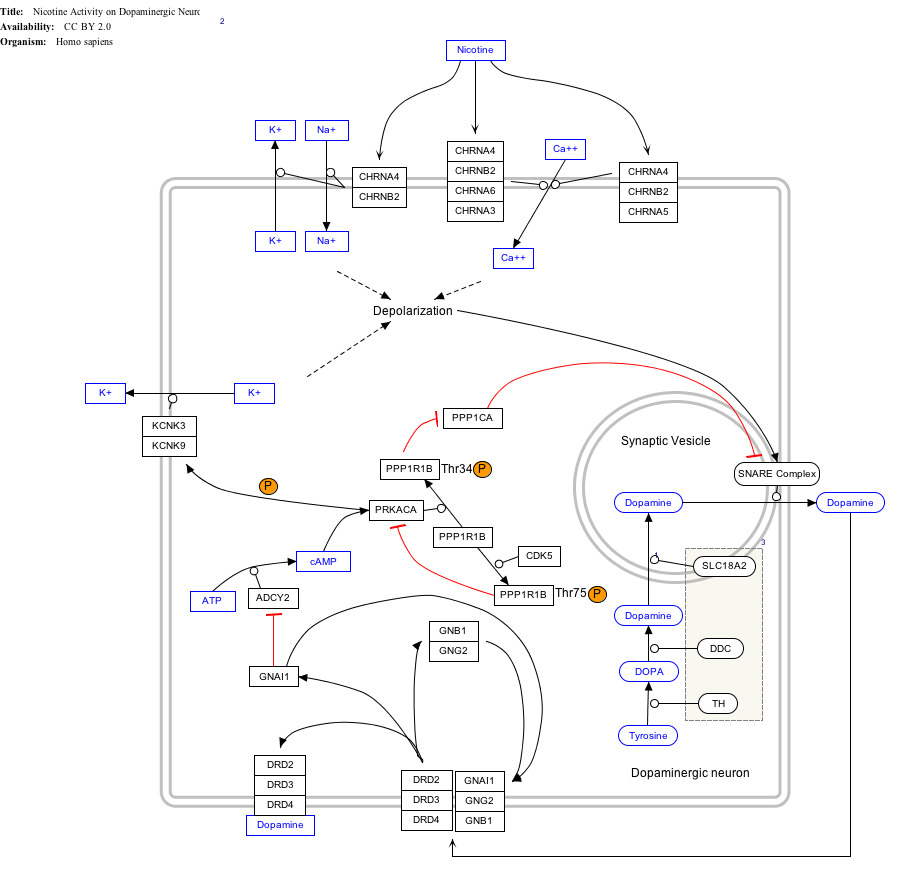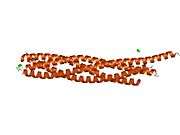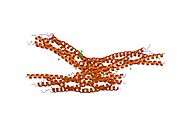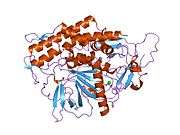SNAP25
| View/Edit Human | View/Edit Mouse |
Synaptosomal-associated protein 25 (SNAP-25) is a t-SNARE protein that is encoded by the SNAP25 gene in humans.[3] SNAP-25 is a component of the trans-SNARE complex, which is proposed to account for the specificity of membrane fusion and to directly execute fusion by forming a tight complex that brings the synaptic vesicle and plasma membranes together.[4]
Structure and function
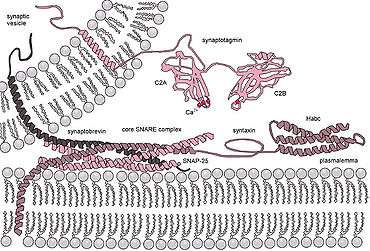
SNAP-25, a Q-SNARE protein, is anchored to the cytosolic face of membranes via palmitoyl side chains covalently bound to cysteine amino acid residues in the middle of the molecule. This means that SNAP-25 does not contain a trans-membrane domain.[6]
SNAP-25 has been identified in contributing two α-helices to the SNARE complex, a four-α-helix domain complex.[7] The SNARE complex participates in vesicle fusion, which involves the docking and merging of a vesicle with the cell membrane to bring about an exocytotic event. Synaptobrevin, a protein that is a part of the vesicle-associated membrane protein (VAMP) family, and syntaxin-1 also help form the SNARE complex by each contributing one α-helix. SNAP-25 assembles with synaptobrevin and syntaxin-1 and the selective binding of these proteins enables vesicle docking and fusion to occur at the correct location.[8]
To form the SNARE complex, synaptobrevin, syntaxin-1, and SNAP-25 associate and begin to wrap around each other to form a coiled coil quaternary structure. The α-helices of both synaptobrevin and syntaxin-1 bind to those of SNAP-25. Synaptobrevin binds the α-helix near SNAP-25's C-terminal side, while syntaxin-1 binds the α-helix near the N-terminus.[6]
SNAP-25 inhibits presynaptic P-, Q-, and L-type voltage-gated calcium channels[9] and interacts with the synaptotagmin C2B domain in Ca2+-independent fashion.[10] In glutamatergic synapses, SNAP-25 decreases the Ca2+ responsiveness, while it is naturally absent in GABAergic synapses.[11]
Two isoforms (mRNA splice variants) of SNAP-25 exist, which are labeled A and B. There are nine amino acid residue differences between the two isoforms, including a re-localization of one of the four cysteine residues.[12] The major characteristics of these two forms are outlined in the table below.
| SNAP25A | SNAP25B | |
|---|---|---|
| Structure | N-terminal α-helix
Random coil linker region with four cysteines clustered towards the center C-terminal α-helix |
N-terminal α-helix
Random coil linker region with four cysteines clustered towards the C-terminus C-terminal α-helix |
| Expression | Major SNAP-25 isoform in embryos and developing neural tissue
Minimal expression in adult tissue except in pituitary and adrenal gland tissues |
Minimal expression during development, major isoform in adult neural tissue[13] |
| Localization | Diffuse | Localized to terminals and varicosities[13] |
Clinical significance
Consistent with the regulation of synaptic Ca2+ responsiveness, heterozygous deletion of the SNAP-25 gene in mice results in a hyperactive phenotype similar to attention deficit hyperactivity disorder (ADHD). In heterozygous mice, a decrease in hyperactivity is observed with dextroamphetamine (or Dexedrine), an active ingredient in the ADHD drug Adderall. Homozygous deletions of the SNAP-25 gene are lethal. Subsequent studies have suggested that at least some of the SNAP-25 gene mutations in humans might predispose to ADHD.[14][15]
A genome wide association study pointed to the rs362584 polymorphism in the gene as possibly associated with the personality trait neuroticism.[16] Botulinum toxins A, C and E cleave SNAP-25,[17] leading to paralysis in clinically developed botulism.
Interactive pathway map
Click on genes, proteins and metabolites below to link to respective articles. [§ 1]
Nicotine Activity on Dopaminergic Neurons edit
- ↑ The interactive pathway map can be edited at WikiPathways: "NicotineDopaminergic_WP1602".
Interactions
SNAP-25 has been shown to interact with:
References
- ↑ "Human PubMed Reference:".
- ↑ "Mouse PubMed Reference:".
- ↑ Maglott DR, Feldblyum TV, Durkin AS, Nierman WC (May 1996). "Radiation hybrid mapping of SNAP, PCSK2, and THBD (human chromosome 20p)". Mamm. Genome. 7 (5): 400–1. doi:10.1007/s003359900120. PMID 8661740.
- ↑ Rizo J, Südhof TC (2002). "Snares and Munc18 in synaptic vesicle fusion". Nat Rev Neurosci. 3 (8): 641–653. doi:10.1038/nrn898. PMID 12154365.
- ↑ Georgiev, Danko D; James F . Glazebrook (2007). "Subneuronal processing of information by solitary waves and stochastic processes". In Lyshevski, Sergey Edward. Nano and Molecular Electronics Handbook. Nano and Microengineering Series. CRC Press. pp. 17–1–17–41. doi:10.1201/9781420008142.ch17 (inactive 2015-10-24). ISBN 978-0-8493-8528-5.
- 1 2 Chapman ER, An S, Barton N, Jahn R (1994). "SNAP-25, a t-SNARE which binds to both syntaxin and synaptobrevin via domains that may form coiled coils". J. Biol. Chem. 269 (44): 27427–32. PMID 7961655.
- ↑ Pevsner J, Hsu SC, Braun JE, Calakos N, Ting AE, Bennett MK, Scheller RH (1994). "Specificity and regulation of a synaptic vesicle docking complex". Neuron. 13 (2): 353–61. doi:10.1016/0896-6273(94)90352-2. PMID 8060616.
- ↑ Calakos N, Bennett MK, Peterson KE, Scheller RH (1994). "Protein-protein interactions contributing to the specificity of intracellular vesicular trafficking". Science. 263 (5150): 1146–9. Bibcode:1994Sci...263.1146C. doi:10.1126/science.8108733. PMID 8108733.
- ↑ Hodel A (October 1998). "SNAP-25". Int. J. Biochem. Cell Biol. 30 (10): 1069–73. doi:10.1016/S1357-2725(98)00079-X. PMID 9785471.
- ↑ Chapman ER (July 2002). "Synaptotagmin: a Ca(2+) sensor that triggers exocytosis?" (PDF). Nat. Rev. Mol. Cell Biol. 3 (7): 498–508. doi:10.1038/nrm855. PMID 12094216. Archived from the original (PDF) on August 29, 2006.
- ↑ Verderio C, Pozzi D, Pravettoni E, Inverardi F, Schenk U, Coco S, Proux-Gillardeaux V, Galli T, Rossetto O, Frassoni C, Matteoli M (February 2004). "SNAP-25 modulation of calcium dynamics underlies differences in GABAergic and glutamatergic responsiveness to depolarization". Neuron. 41 (4): 599–610. doi:10.1016/S0896-6273(04)00077-7. PMID 14980208.
- ↑ Nagy G, Milosevic I, Fasshauer D, Müller EM, de Groot BL, Lang T, Wilson MC, Sørensen JB (December 2005). "Alternative splicing of SNAP-25 regulates secretion through nonconservative substitutions in the SNARE domain". Mol. Biol. Cell. 16 (12): 5675–85. doi:10.1091/mbc.E05-07-0595. PMC 1289412
 . PMID 16195346.
. PMID 16195346. - 1 2 Bark, Christina (February 1995). "Differential expression of SNAP-25 protein isoforms during divergent vesicle fusion events of neural development" (PDF). Proceedings of the National Academy of Sciences. 92 (5): 1510–1514. Bibcode:1995PNAS...92.1510B. doi:10.1073/pnas.92.5.1510. Retrieved 18 October 2014.
- ↑ Brophy K, Hawi Z, Kirley A, Fitzgerald M, Gill M (2002). "Synaptosomal-associated protein 25 (SNAP-25) and attention deficit hyperactivity disorder (ADHD): evidence of linkage and association in the Irish population". Mol. Psychiatry. 7 (8): 913–7. doi:10.1038/sj.mp.4001092. PMID 12232787.
- ↑ Mill J, Curran S, Kent L, Gould A, Huckett L, Richards S, Taylor E, Asherson P (April 2002). "Association study of a SNAP-25 microsatellite and attention deficit hyperactivity disorder". Am. J. Med. Genet. 114 (3): 269–71. doi:10.1002/ajmg.10253. PMID 11920846.
- ↑ Terracciano A, Sanna S, Uda M, Deiana B, Usala G, Busonero F, Maschio A, Scally M, Patriciu N, Chen WM, Distel MA, Slagboom EP, Boomsma DI, Villafuerte S, Sliwerska E, Burmeister M, Amin N, Janssens AC, van Duijn CM, Schlessinger D, Abecasis GR, Costa PT (October 2008). "Genome-wide association scan for five major dimensions of personality". Mol. Psychiatry. 15 (6): 647–56. doi:10.1038/mp.2008.113. PMC 2874623
 . PMID 18957941.
. PMID 18957941. - ↑ Aoki KR, Guyer B (November 2001). "Botulinum toxin type A and other botulinum toxin serotypes: a comparative review of biochemical and pharmacological actions". Eur. J. Neurol. 8 Suppl 5: 21–9. doi:10.1046/j.1468-1331.2001.00035.x. PMID 11851731.
- 1 2 3 Chen X, Tomchick DR, Kovrigin E, Araç D, Machius M, Südhof TC, Rizo J (January 2002). "Three-dimensional structure of the complexin/SNARE complex". Neuron. 33 (3): 397–409. doi:10.1016/s0896-6273(02)00583-4. PMID 11832227.
- ↑ Hu K, Carroll J, Rickman C, Davletov B (November 2002). "Action of complexin on SNARE complex". J. Biol. Chem. 277 (44): 41652–6. doi:10.1074/jbc.M205044200. PMID 12200427.
- ↑ Okamoto M, Schoch S, Südhof TC (June 1999). "EHSH1/intersectin, a protein that contains EH and SH3 domains and binds to dynamin and SNAP-25. A protein connection between exocytosis and endocytosis?". J. Biol. Chem. 274 (26): 18446–54. doi:10.1074/jbc.274.26.18446. PMID 10373452.
- ↑ Diefenbach RJ, Diefenbach E, Douglas MW, Cunningham AL (Dec 2002). "The heavy chain of conventional kinesin interacts with the SNARE proteins SNAP25 and SNAP23". Biochemistry. 41 (50): 14906–15. doi:10.1021/bi026417u. PMID 12475239.
- 1 2 Ilardi JM, Mochida S, Sheng ZH (February 1999). "Snapin: a SNARE-associated protein implicated in synaptic transmission". Nat. Neurosci. 2 (2): 119–24. doi:10.1038/5673. PMID 10195194.
- 1 2 Stelzl U, Worm U, Lalowski M, Haenig C, Brembeck FH, Goehler H, Stroedicke M, Zenkner M, Schoenherr A, Koeppen S, Timm J, Mintzlaff S, Abraham C, Bock N, Kietzmann S, Goedde A, Toksöz E, Droege A, Krobitsch S, Korn B, Birchmeier W, Lehrach H, Wanker EE (September 2005). "A human protein-protein interaction network: a resource for annotating the proteome". Cell. 122 (6): 957–68. doi:10.1016/j.cell.2005.08.029. PMID 16169070.
- ↑ Rual JF, Venkatesan K, Hao T, Hirozane-Kishikawa T, Dricot A, Li N, Berriz GF, Gibbons FD, Dreze M, Ayivi-Guedehoussou N, Klitgord N, Simon C, Boxem M, Milstein S, Rosenberg J, Goldberg DS, Zhang LV, Wong SL, Franklin G, Li S, Albala JS, Lim J, Fraughton C, Llamosas E, Cevik S, Bex C, Lamesch P, Sikorski RS, Vandenhaute J, Zoghbi HY, Smolyar A, Bosak S, Sequerra R, Doucette-Stamm L, Cusick ME, Hill DE, Roth FP, Vidal M (October 2005). "Towards a proteome-scale map of the human protein-protein interaction network". Nature. 437 (7062): 1173–8. Bibcode:2005Natur.437.1173R. doi:10.1038/nature04209. PMID 16189514.
- 1 2 3 4 Hata Y, Südhof TC (June 1995). "A novel ubiquitous form of Munc-18 interacts with multiple syntaxins. Use of the yeast two-hybrid system to study interactions between proteins involved in membrane traffic". J. Biol. Chem. 270 (22): 13022–8. doi:10.1074/jbc.270.22.13022. PMID 7768895.
- 1 2 3 4 Ravichandran V, Chawla A, Roche PA (June 1996). "Identification of a novel syntaxin- and synaptobrevin/VAMP-binding protein, SNAP-23, expressed in non-neuronal tissues". J. Biol. Chem. 271 (23): 13300–3. doi:10.1074/jbc.271.23.13300. PMID 8663154.
- 1 2 3 Steegmaier M, Yang B, Yoo JS, Huang B, Shen M, Yu S, Luo Y, Scheller RH (Dec 1998). "Three novel proteins of the syntaxin/SNAP-25 family". J. Biol. Chem. 273 (51): 34171–9. doi:10.1074/jbc.273.51.34171. PMID 9852078.
- ↑ Dulubova I, Sugita S, Hill S, Hosaka M, Fernandez I, Südhof TC, Rizo J (August 1999). "A conformational switch in syntaxin during exocytosis: role of munc18". EMBO J. 18 (16): 4372–82. doi:10.1093/emboj/18.16.4372. PMC 1171512
 . PMID 10449403.
. PMID 10449403. - ↑ McMahon HT, Missler M, Li C, Südhof TC (October 1995). "Complexins: cytosolic proteins that regulate SNAP receptor function". Cell. 83 (1): 111–9. doi:10.1016/0092-8674(95)90239-2. PMID 7553862.
- ↑ Gonelle-Gispert C, Molinete M, Halban PA, Sadoul K (September 2000). "Membrane localization and biological activity of SNAP-25 cysteine mutants in insulin-secreting cells". J. Cell. Sci. 113 (18): 3197–205. PMID 10954418.
- 1 2 3 Li Y, Chin LS, Weigel C, Li L (November 2001). "Spring, a novel RING finger protein that regulates synaptic vesicle exocytosis". J. Biol. Chem. 276 (44): 40824–33. doi:10.1074/jbc.M106141200. PMID 11524423.
- ↑ Chapman ER, An S, Barton N, Jahn R (November 1994). "SNAP-25, a t-SNARE which binds to both syntaxin and synaptobrevin via domains that may form coiled coils". J. Biol. Chem. 269 (44): 27427–32. PMID 7961655.
- ↑ Reed GL, Houng AK, Fitzgerald ML (April 1999). "Human platelets contain SNARE proteins and a Sec1p homologue that interacts with syntaxin 4 and is phosphorylated after thrombin activation: implications for platelet secretion". Blood. 93 (8): 2617–26. PMID 10194441.
- ↑ Gerona RR, Larsen EC, Kowalchyk JA, Martin TF (March 2000). "The C terminus of SNAP25 is essential for Ca(2+)-dependent binding of synaptotagmin to SNARE complexes". J. Biol. Chem. 275 (9): 6328–36. doi:10.1074/jbc.275.9.6328. PMID 10692432.
- ↑ Zhang X, Kim-Miller MJ, Fukuda M, Kowalchyk JA, Martin TF (May 2002). "Ca2+-dependent synaptotagmin binding to SNAP-25 is essential for Ca2+-triggered exocytosis". Neuron. 34 (4): 599–611. doi:10.1016/s0896-6273(02)00671-2. PMID 12062043.
- ↑ Hao JC, Salem N, Peng XR, Kelly RB, Bennett MK (March 1997). "Effect of mutations in vesicle-associated membrane protein (VAMP) on the assembly of multimeric protein complexes". J. Neurosci. 17 (5): 1596–603. PMID 9030619.
Further reading
- Hanson PI, Otto H, Barton N, Jahn R (1995). "The N-ethylmaleimide-sensitive fusion protein and alpha-SNAP induce a conformational change in syntaxin.". J. Biol. Chem. 270 (28): 16955–61. doi:10.1074/jbc.270.28.16955. PMID 7622514.
- Hata Y, Südhof TC (1995). "A novel ubiquitous form of Munc-18 interacts with multiple syntaxins. Use of the yeast two-hybrid system to study interactions between proteins involved in membrane traffic.". J. Biol. Chem. 270 (22): 13022–8. doi:10.1074/jbc.270.22.13022. PMID 7768895.
- Chapman ER, An S, Barton N, Jahn R (1994). "SNAP-25, a t-SNARE which binds to both syntaxin and synaptobrevin via domains that may form coiled coils.". J. Biol. Chem. 269 (44): 27427–32. PMID 7961655.
- Zhao N, Hashida H, Takahashi N, Sakaki Y (1994). "Cloning and sequence analysis of the human SNAP25 cDNA.". Gene. 145 (2): 313–4. doi:10.1016/0378-1119(94)90027-2. PMID 8056350.
- Bark IC, Wilson MC (1994). "Human cDNA clones encoding two different isoforms of the nerve terminal protein SNAP-25.". Gene. 139 (2): 291–2. doi:10.1016/0378-1119(94)90773-0. PMID 8112622.
- Maruyama K, Sugano S (1994). "Oligo-capping: a simple method to replace the cap structure of eukaryotic mRNAs with oligoribonucleotides". Gene. 138 (1–2): 171–4. doi:10.1016/0378-1119(94)90802-8. PMID 8125298.
- Maglott DR, Feldblyum TV, Durkin AS, Nierman WC (1996). "Radiation hybrid mapping of SNAP, PCSK2, and THBD (human chromosome 20p).". Mamm. Genome. 7 (5): 400–1. doi:10.1007/s003359900120. PMID 8661740.
- Ravichandran V, Chawla A, Roche PA (1996). "Identification of a novel syntaxin- and synaptobrevin/VAMP-binding protein, SNAP-23, expressed in non-neuronal tissues.". J. Biol. Chem. 271 (23): 13300–3. doi:10.1074/jbc.271.23.13300. PMID 8663154.
- Rettig J, Sheng ZH, Kim DK, Hodson CD, Snutch TP, Catterall WA (1996). "Isoform-specific interaction of the alpha1A subunits of brain Ca2+ channels with the presynaptic proteins syntaxin and SNAP-25". Proc. Natl. Acad. Sci. U.S.A. 93 (14): 7363–8. Bibcode:1996PNAS...93.7363R. doi:10.1073/pnas.93.14.7363. PMC 38990
 . PMID 8692999.
. PMID 8692999. - Jagadish MN, Fernandez CS, Hewish DR, Macaulay SL, Gough KH, Grusovin J, Verkuylen A, Cosgrove L, Alafaci A, Frenkel MJ, Ward CW (1996). "Insulin-responsive tissues contain the core complex protein SNAP-25 (synaptosomal-associated protein 25) A and B isoforms in addition to syntaxin 4 and synaptobrevins 1 and 2.". Biochem. J. 317 (3): 945–54. doi:10.1042/bj3170945. PMC 1217577
 . PMID 8760387.
. PMID 8760387. - Betz A, Okamoto M, Benseler F, Brose N (1997). "Direct interaction of the rat unc-13 homologue Munc13-1 with the N terminus of syntaxin.". J. Biol. Chem. 272 (4): 2520–6. doi:10.1074/jbc.272.4.2520. PMID 8999968.
- Araki S, Tamori Y, Kawanishi M, Shinoda H, Masugi J, Mori H, Niki T, Okazawa H, Kubota T, Kasuga M (1997). "Inhibition of the binding of SNAP-23 to syntaxin 4 by Munc18c.". Biochem. Biophys. Res. Commun. 234 (1): 257–62. doi:10.1006/bbrc.1997.6560. PMID 9168999.
- Lane SR, Liu Y (1997). "Characterization of the palmitoylation domain of SNAP-25.". J. Neurochem. 69 (5): 1864–9. doi:10.1046/j.1471-4159.1997.69051864.x. PMID 9349529.
- Suzuki Y, Yoshitomo-Nakagawa K, Maruyama K, Suyama A, Sugano S (1997). "Construction and characterization of a full length-enriched and a 5'-end-enriched cDNA library". Gene. 200 (1–2): 149–56. doi:10.1016/S0378-1119(97)00411-3. PMID 9373149.
- Okamoto M, Südhof TC (1998). "Mints, Munc18-interacting proteins in synaptic vesicle exocytosis.". J. Biol. Chem. 272 (50): 31459–64. doi:10.1074/jbc.272.50.31459. PMID 9395480.
- Low SH, Roche PA, Anderson HA, van Ijzendoorn SC, Zhang M, Mostov KE, Weimbs T (1998). "Targeting of SNAP-23 and SNAP-25 in polarized epithelial cells.". J. Biol. Chem. 273 (6): 3422–30. doi:10.1074/jbc.273.6.3422. PMID 9452464.
- Poirier MA, Hao JC, Malkus PN, Chan C, Moore MF, King DS, Bennett MK (1998). "Protease resistance of syntaxin.SNAP-25.VAMP complexes. Implications for assembly and structure.". J. Biol. Chem. 273 (18): 11370–7. doi:10.1074/jbc.273.18.11370. PMID 9556632.
- Prekeris R, Klumperman J, Chen YA, Scheller RH (1998). "Syntaxin 13 mediates cycling of plasma membrane proteins via tubulovesicular recycling endosomes.". J. Cell Biol. 143 (4): 957–71. doi:10.1083/jcb.143.4.957. PMC 2132958
 . PMID 9817754.
. PMID 9817754. - Gonelle-Gispert C, Halban PA, Niemann H, Palmer M, Catsicas S, Sadoul K (1999). "SNAP-25a and -25b isoforms are both expressed in insulin-secreting cells and can function in insulin secretion.". Biochem. J. 339 (1): 159–65. doi:10.1042/0264-6021:3390159. PMC 1220140
 . PMID 10085240.
. PMID 10085240. - Ilardi JM, Mochida S, Sheng ZH (1999). "Snapin: a SNARE-associated protein implicated in synaptic transmission.". Nat. Neurosci. 2 (2): 119–24. doi:10.1038/5673. PMID 10195194.
External links
- SNAP25 Protein at the US National Library of Medicine Medical Subject Headings (MeSH)
This article incorporates text from the public domain Pfam and InterPro IPR000928


